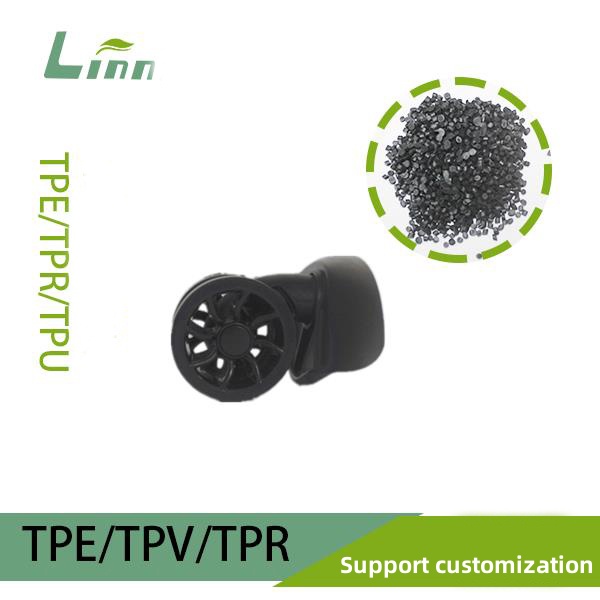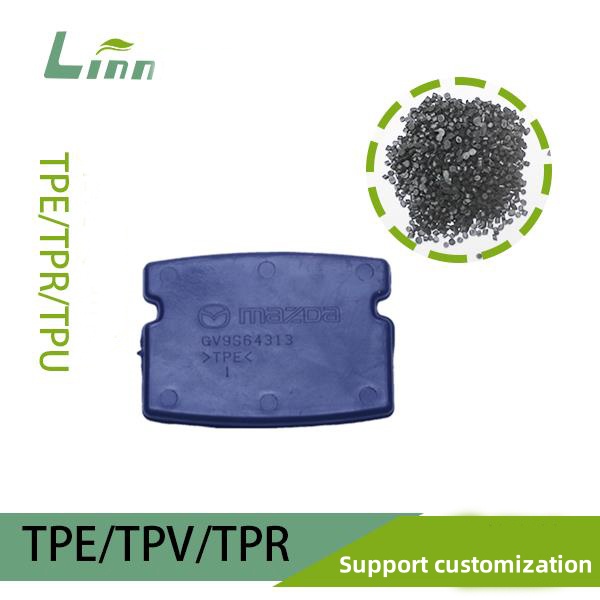As someone who has worked in the field of thermoplastic elastomers (TPE) for years, I often hear this question: “Why does my TPE material get softer over time?” It sounds like a simple issue, but the reasons behind it involve complex material science, subtle differences in manufacturing processes, and the impact of environmental factors. Today, I want to take you through a detailed exploration of why TPE materials soften, drawing on real-world cases and scientific insights, while also sharing practical solutions to address the problem.

TPE Basics: What Makes It So Special?
Before diving into why TPE softens, let’s briefly cover what makes this material unique. TPE, or thermoplastic elastomer, is a versatile material that combines the elasticity of rubber with the processability of plastics. It’s widely used in automotive parts, medical devices, consumer electronics, sports equipment, and more. The magic of TPE lies in its molecular structure: hard segments provide strength and rigidity, while soft segments deliver elasticity. This “best of both worlds” characteristic makes TPE an ideal replacement for traditional rubber or plastics in many applications.
However, this complex structure is also why TPE can sometimes soften unexpectedly. In the sections below, I’ll break down the causes of TPE softening from four key angles: material formulation, manufacturing processes, environmental factors, and aging mechanisms.
Cause 1: Issues with Material Formulation
The performance of TPE heavily depends on its formulation. Different applications require specific hardness and elasticity levels, which are determined by the following components:
Base resin: Such as SEBS (styrene-ethylene-butylene-styrene) or TPU (thermoplastic polyurethane).
Plasticizers: Typically mineral or synthetic oils, used to adjust softness.
Fillers: Such as calcium carbonate or talc, which affect cost and physical properties.
Additives: Including antioxidants and UV stabilizers to enhance durability.
If the formulation contains too much plasticizer, the TPE may feel overly soft from the start or lack sufficient rigidity. Worse, low-quality plasticizers can volatilize or migrate over time, causing the material to soften further and sometimes become sticky.

Real-World Case Study
I once worked with a client whose TPE handle grips softened significantly after six months of use, with some users reporting a “sticky” feel. After testing, we found that the supplier had used an excessive amount of low-molecular-weight mineral oil in the formulation. This oil migrated to the surface under heat or prolonged use, reducing hardness. We recommended adjusting the formulation to reduce plasticizer content and switch to a high-molecular-weight synthetic oil, which resolved the issue.
Solutions:
Work closely with suppliers to ensure plasticizer levels are appropriate (typically 20%-40% of total mass, depending on the application).
Opt for high-molecular-weight, stable plasticizers to minimize volatilization or migration.
Request detailed material data sheets (MSDS) and performance test reports during procurement.
Cause 2: Manufacturing Process Errors
Even with a well-designed formulation, mistakes during production can lead to TPE softening. TPE is typically processed through extrusion, injection molding, or blow molding, all of which require precise control of temperature, pressure, and cooling rates.
Common Manufacturing Issues
Excessive processing temperatures: High temperatures can cause molecular chain degradation, particularly in the hard segments, resulting in softening.
Uneven mixing: Poor dispersion of plasticizers or fillers can create soft spots, compromising overall performance.
Improper cooling: Rapid cooling may trap internal stresses, leading to deformation or softening over time.

My Experience
I once helped a factory troubleshoot why their TPE hoses were softening. The hoses performed well in lab tests but failed in real-world use. On-site, I discovered that their injection molding machine was set to a temperature higher than the recommended range for TPE (typically 180-220°C, depending on the grade). This caused partial degradation of the SEBS base resin’s hard segments, reducing rigidity. By adjusting the temperature and optimizing the cooling process, we fixed the issue.
Solutions:
Strictly follow the processing parameters provided by the TPE supplier, especially for temperature and screw speed.
Regularly calibrate equipment to ensure consistent mixing and molding.
Conduct small-batch testing during the initial production phase to validate process parameters.
Cause 3: Environmental Factors
TPE performance isn’t just about the material itself—it’s also heavily influenced by the environment it’s used in. Here are key environmental factors that can cause softening:
1. High Temperatures
TPE’s glass transition temperature (Tg) is typically low (-50°C to 0°C, depending on the formulation). In hot environments (e.g., inside a car during summer or near industrial equipment), the soft segments become more active, making the material feel softer. If temperatures approach or exceed the TPE’s softening point (usually 80-120°C), the hard segments may suffer irreversible damage, leading to permanent softening.
2. Chemical Exposure
TPE is sensitive to certain chemicals, such as oils, solvents, or acids. Prolonged exposure can cause plasticizers to leach out or molecular chains to break, resulting in softening. For example, surfactants in household cleaners may penetrate TPE, disrupting its structure.

3. UV Radiation and Oxidation
Long-term exposure to sunlight subjects TPE to ultraviolet (UV) radiation and oxygen, triggering photo-oxidative aging. This can soften the material, cause surface cracking, or lead to color fading.
Supporting Data
According to the American Society for Testing and Materials (ASTM), TPE exposed to 80°C for 1,000 hours may experience a hardness reduction of 10-20 Shore A. In UV accelerated aging tests (ASTM G154), the hardness drop can be even greater, up to 30% in some cases.
Solutions:
Select TPE grades suited to the environment, such as high-temperature or chemical-resistant types.
Incorporate UV stabilizers (e.g., UV-531) or antioxidants (e.g., Irganox 1010) to improve weatherability.
Avoid prolonged exposure of TPE products to high heat, sunlight, or chemicals.
Cause 4: Material Aging and Fatigue
Even without harsh environmental conditions, TPE will naturally age over time. This can happen due to:
Molecular chain scission: Repeated mechanical stress or thermal-oxidative effects can break molecular chains, reducing hardness.
Plasticizer migration: Plasticizers may gradually move to the surface or evaporate, softening the material.
Fatigue damage: Repeated stretching, compression, or bending can cause micro-damage to TPE’s internal structure, manifesting as softening or deformation.
My Observation
I once analyzed a TPE yoga mat that softened significantly after a year of use, losing its supportive feel. Using scanning electron microscopy (SEM), we found micro-cracks on the surface and signs of molecular chain scission inside. This suggested that a combination of mechanical stress and natural aging caused the performance decline.
Solutions:
Choose TPE bases with better aging resistance, such as high-molecular-weight SEBS or TPU.
Design products with fatigue life in mind, avoiding excessive stretching or compression.
Replace TPE products periodically, especially in high-stress applications.

Summary of TPE Softening Causes and Solutions
To make this clearer, here’s a table summarizing the causes of TPE softening and their solutions:
| Cause | Details | Solutions |
|---|---|---|
| Formulation Issues | Excessive or low-quality plasticizers leading to volatilization or migration. | Optimize formulation, reduce plasticizer content, use high-molecular-weight types, and request detailed data from suppliers. |
| Manufacturing Errors | High processing temperatures, uneven mixing, or improper cooling causing degradation or stress. | Follow supplier parameters, calibrate equipment, and test small batches. |
| Environmental Factors | Heat, chemicals, or UV exposure causing chain scission or plasticizer loss. | Choose appropriate TPE grades, add stabilizers, and avoid harsh conditions. |
| Aging and Fatigue | Molecular chain breakdown, plasticizer migration, or mechanical fatigue. | Use durable bases, design for fatigue resistance, and replace products periodically. |
How to Choose the Right TPE Material?
Preventing TPE softening is far easier than fixing it after the fact. Here are my top tips for selecting the right TPE:
Define the Application: Match the TPE grade to the environment (temperature, chemical exposure, mechanical stress). For example, automotive interiors need high-temperature TPE, while medical devices require chemical resistance.
Collaborate with Suppliers: Don’t just focus on cost—prioritize suppliers with technical support and reliable supply chains. Request long-term performance data, such as aging or fatigue test results.
Conduct Thorough Testing: Before full-scale production, run environmental simulations (e.g., heat aging, UV exposure, chemical soaking) to ensure the material meets requirements.
Follow Industry Standards: Use ASTM or ISO standards to verify TPE’s hardness, weatherability, and mechanical properties.

FAQs: Addressing Your Concerns
To round out this discussion, here are answers to some common questions about TPE softening:
Q1: Can softened TPE regain its original hardness?
A: Softening due to aging or molecular chain breakdown is generally irreversible. If surface stickiness is caused by plasticizer migration, cleaning the surface and applying a protective coating (e.g., silicone oil) may improve the feel temporarily. However, this is a short-term fix—focus on optimizing material and processes for lasting results.
Q2: How can I tell if TPE softening is due to formulation or environmental factors?
A: Lab testing can help. Use Fourier Transform Infrared Spectroscopy (FTIR) to check for excessive or migrated plasticizers, Thermogravimetric Analysis (TGA) to detect chain degradation, or environmental simulations (e.g., heat or UV exposure) to assess external impacts. Consider consulting a professional testing lab.
Q3: Is there a TPE that never softens?
A: No TPE is completely immune to softening, as all polymers age over time. However, optimized formulations (e.g., high-weatherability bases and additives) and thoughtful design can significantly delay softening. High-end TPU grades, for instance, perform well in harsh conditions.
Q4: Does TPE softening affect safety?
A: It depends on the application. For example, softened TPE in medical devices could compromise seals, posing risks, while softened automotive parts might reduce structural integrity. Design with performance margins and inspect critical components regularly.
Final Thoughts
The softening of TPE materials may seem like a minor issue, but it can stem from a web of factors—formulation, manufacturing, environment, and aging. As someone who’s spent years in this field, I’ve seen how attention to detail can make all the difference. My hope is that this article has given you a clearer understanding of TPE’s behavior and actionable steps to tackle softening.
If you’re grappling with TPE softening, start by reviewing the formulation, refining manufacturing processes, and optimizing the use environment. Feel free to reach out with questions—I’m happy to share more insights from my experience. Together, let’s unlock the full potential of TPE in your projects!





